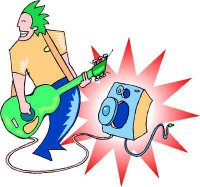
At some point, you or one of your students will want to use a popular song as a background in a video production. And as nice as it could be to hear a current song while you are watching football highlights, remember that you are using someone else's property without permission. And that can bring on a heap of trouble.
Remember that it's not "music," it's the "music business." Somebody owns the song, someone else owns the recording of that song. And they all hope to make money by selling what you want to steal.
But, if you buy the CD, don't you own the right to put one of the songs onto your video?
Nope.
Another question that I am asked: is it acceptable if you have a student perform the song in question, instead of using the original recording?
Remember that someone owns that song, the words and the music. So having Johnny perform the song in question is using their property without permission. It's still a copyright violation.
I've heard all the excuses for using copyrighted music:
But the kids really like it.
Who is going to know?
We're a school; nobody would sue us.
I bought the CD, isn't that good enough?
And my favorite:
But I got it on the internet...doesn't that mean I can use it?
I guarantee that sticking to the law won't make you popular with the students who want to use "their" music on a school video. But it will keep you out of trouble, and that should keep you (and your administrators) happy.
Here are some suggestions that should help you along this slippery path. And a disclaimer: I'm not a lawyer, and I don't even play one on TV. As always, consult an attorney for legal advice.
1. To be 100% safe, don't use copyrighted music without written permission from the copyright holders. Instead, use copyright-free music or buyout music.
2. If you choose to use copyrighted material, consult the Fair Use Guidelines for Music:
a. Use 10% of a song, not to exceed 30 seconds,
and do not show the finished video out of the classroom.
Do not duplicate, distribute, broadcast, webcast or sell it.
b. Proper attribution must be given when using copyrighted materials. i.e.
"I Am Your Child" written by Barry Manilow/Martin Panzer.
BMG Music/SwanneeBravo Music.
c. The opening screen of the project must include a notice that "certain materials are included under the fair use exemption and have been used according to the multimedia fair use guidelines".
d. Your fair use of material ends when the project creator (student or teacher) loses control of the project's use: e.g. when it is distributed, copied or broadcast.
3. If you wish to use more than 10% of a copyrighted song, you must obtain written gratis permission from the music publisher and the record company. This is a long process with limited chance of success.
4. Remember that music publishing firms will litigate schools and institutions who violate copyright laws. Fines can be thousands of dollars per violation.
No comments:
Post a Comment